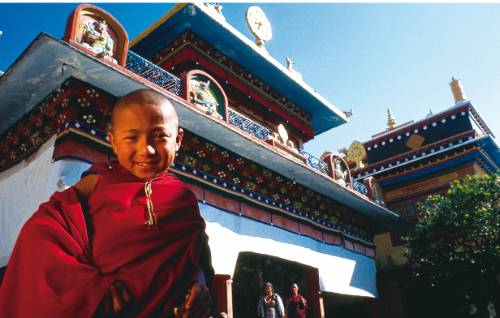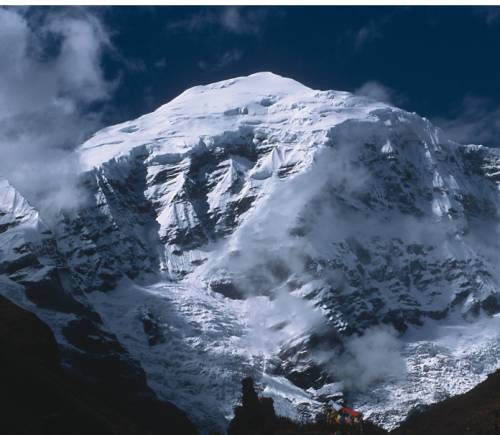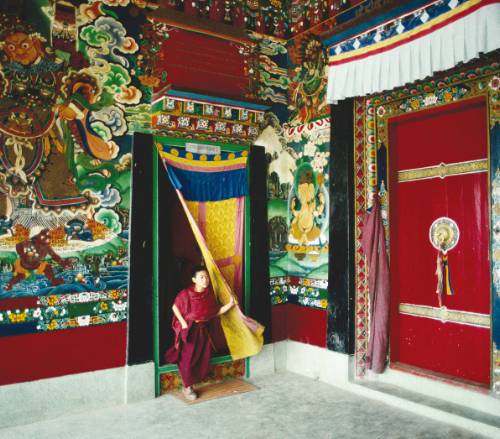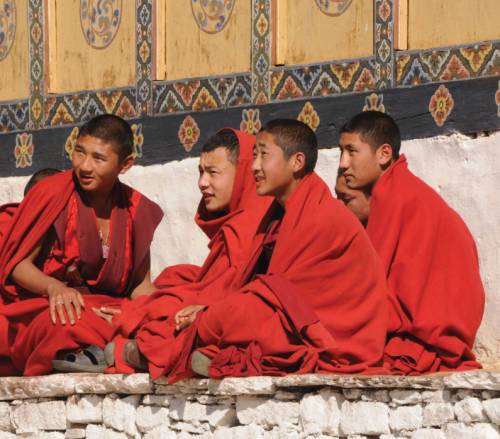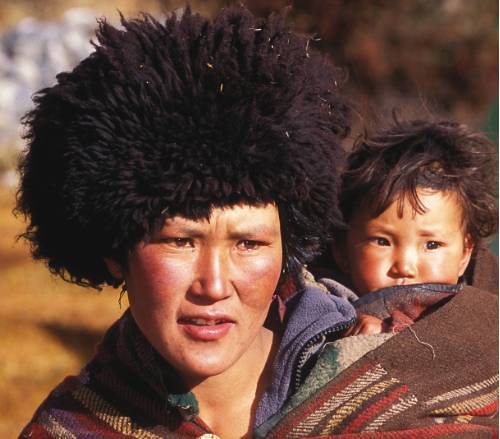Bhutan Explorer & Jambay Lhakhang Festival
Bhutan Explorer & Jambay Lhakhang Festival
$6390
Tour Overview
Embark on an unforgettable journey through the mystical kingdom of Bhutan with the "Bhutan Explorer & Jambay Lhakhang Festival" tour. This immersive experience takes you to the heart of Bhutanese culture, where you'll witness the vibrant Jambay Lhakhang festival in Bumthang, explore the remote Tang Valley, and marvel at ancient dzongs and monasteries, including the iconic Taktsang (Tiger's Nest) and Punakha Dzong. Traverse the breathtaking landscapes of Gangtey Valley, home to the elusive Black-necked crane, and absorb the majestic views of Jomolhari, Bhutan's sacred mountain. With 11 nights of comfortable accommodation, all meals included, and the guidance of an English-speaking local expert, this tour offers a deep dive into Bhutan's rich heritage and stunning natural beauty. Enjoy private transport, airport transfers, and all necessary permits, ensuring a seamless and enriching adventure in this enchanting Himalayan kingdom. ...more ...less
Highlights
Itinerary
Day 1 : Arrive Paro (2280m) and drive to Thimphu (2400m)
Location: Thimphu
Accommodation Name: Hotel Riverview or similar
Meals Included: Breakfast, Lunch, Dinner
Welcome to Bhutan! On arrival you meet your Bhutanese guide and driver who will greet you with a BIG Kuzu Zangpola (Welcome).
We drive to Thimphu (approx 1 hr drive) and check into the hotel overlooking the Thimphu valley. This is the first proper glimpse of Bhutan but you should be aware that this is the most developed urban center in Bhutan, very unique from any capital of the world.
Home to the government, the royal family and the head offices of all international organization Thimphu has changed radically in the last decade. After a quick freshen up we begin the Bhutan Experience by visiting the Buddha Dordenma, the largest sitting statue of Buddha in the World. This statue sits atop a hill protectively overlooking the Thimphu valley below.
In the evening, our guide will conduct a thorough tour briefing outlining the trip ahead.
Overnight: Hotel Riverview or similar ...more ...less
Day 2 : Explore Thimphu
Location: Thimphu
Accommodation Name: Hotel Riverview or similar
Meals Included: Breakfast, Lunch, Dinner
We have a day to explore the nation's capital of Thimphu and its plethora of historical museums and sites. Today's activities include visiting the Textile Museum, which showcases the renowned traditional textile arts of Bhutan and displays the royal robes donned by the King and Queen of Bhutan worn at the Royal Wedding in 2012. We also visit a folk heritage museum - offering an insight into the village life of a local farmer, the famed Thimphu Dzong, a magnificent structure that seats the Government and the office of his Majesty. Take some time to admire the architecture of this and other Dzongs as they were constructed without a single nail. Thimphu Dzong is the summer home of the central monk; during winter he moves to Punakha. The tour continues at a painting school that teaches students the thirteen traditional arts and crafts of Bhutan.
Overnight: Hotel Riverview or similar
Day 3 : Drive to Punakha (1300m) via Dochu La (drive approx 4-5 hrs)
Location: Punakha
Accommodation Name: Khuru Resort or similar
Meals Included: Breakfast, Lunch, Dinner
This morning we head off over the Dochu La pass at 3100m feet towards Punakha, where it is relatively warmer than Paro and Thimphu. Punakha is the ancient capital of Bhutan and is dominated by the impressive Punakha Dzong, which sits at the confluence of the Mo (female) and Po (male) rivers. The Central Monk Body moves from Thimphu to Punakha every winter as the lower elevation is more temperate.
Enroute we visit the Chimi Lhakhang (temple) dedicated to the Divine Mad Monk - Drukpa Kuenley, and learn how this Buddhist monk was able to teach people the words of the Buddha through very peculiar and unconventional methods of teaching.
Overnight: Khuru Resort or similar
Day 4 : Explore Punakha
Location: Punakha
Accommodation Name: Khuru Resort or similar
Meals Included: Breakfast, Lunch, Dinner
Today’s day begins with a short hike through rice fields, chillies and cabbage, to the Khamsum Yulley Namgyal Chorten, a monument dedicated to the King of Bhutan, that offers commanding views of the valley floor and up to the high mountains of Gasa. This beautiful trek is about two hours return from the road. Once at the Chorten (stupa) you will be treated with spectacular views of the whole Punakha valley. We will plan a Picnic lunch today in an exclusive campsite by the riverside of Mo Chhu.
Our next stop will be the magnificent Punakha Dzong built on the confluence of the Pho and Mo Chhu (male and female) rivers. The Dzong is the winter residence of the monastic order’s head, with numerous altar rooms and grand courtyards to be explored. Built by Zhabdrung in 1637, Punakha Dzong is one of the most impressive architectural monuments in the country. It houses some of the country’s most sacred relics, including Zhabdrung’s preserved remains.
Bhutan has many trekking levels available, please speak with your guide for options.
Overnight: Khuru Resort or similar
Day 5 : Drive to Trongsa (drive approx 4-5 hrs)
Location: Trongsa
Accommodation Name: Yangkhil Hotel or similar
Meals Included: Breakfast, Lunch, Dinner
In the morning, we continue our journey to Trongsa. Here lies the largest fortress in the kingdom, the Trongsa Dzong, powerhouse of ancient Bhutan. Strategically located on the east-west mule tracks, the governors of Trongsa were the most powerful leaders in the medieval age that gave birth to the monarchial systems in Bhutan, which shaped the history of the country. We visit the precious watch tower known as the Ta Dzong, now converted into a museum. We venture inside to find a small chapel dedicated to King Gesar, an epic hero of Tibetan history, as well as an excellent museum dedicated to the monarchs of Bhutan.
Overnight: Yangkhil Hotel or similar
Day 6 : Drive to Bumthang (drive approx 2.5 hrs)
Location: Bumthang
Accommodation Name: Rinchenling Lodge or similar
Meals Included: Breakfast, Lunch, Dinner
Early morning drive to Bumthang and onwards to Tang Valley - the most remote of Bumthang's valleys. Terton Pema Lingpa, the famous saint responsible for discovering many treasures as prophesied by Guru Rinpoche, was born in this valley. Tang Valley villagers herd sheep and yaks, at higher elevation. Tang Valley combines immense natural beauty with the mystique of playing host to the greatest collection of eminent spiritual practitioners. One such person, Longchen Rabjam and his descendants have built the Ogyenchholing Museum, which was restored in the 19th century. Today it houses the Family Museum, a place that will transport visitors to another world and time. The museum houses exhibits recreated to capture the ambience of the lifestyle of the Trongsa Penlop (Governor), Tshokye Dorji and his household. It also serves as a retreat for those engaged in religious history. Bhutan's history truly unfolds here. Afterwards, we drive to Pema Choling Nunnery where nuns undergo several years of religious studies and live celibate lives. We may be lucky enough to meet and interact with some of the nuns, or even sit in the shrine and hear them chant mantras with bells and drums. Towards the late afternoon we drive to Bumthang for the night. Overnight: Rinchenling Lodge or similar
Day 7 : Jambay Lhakhang Festival, Bumthang
Location: Bumthang
Accommodation Name: Rinchenling Lodge or similar
Meals Included: Breakfast, Lunch, Dinner
This morning we drive to the festival ground of the 7th Century Jambay monastery dedicated to the future Buddha. The festival begins today with the ground purification dance and welcome folk dances by the women of Bumthang. The crowd will slowly pour in as the festival gains momentum. There are different local, national and Tibetan style masked and folk dances that will captivate your attention. Festivals offers an opportunity to immerse yourself into the spirituality of the atmosphere.
Traditional Buddhist festivals in Bhutan are colourful affairs with dancers in elaborate traditional costumes and masks. The dances are designed to bring blessings to the spectators, instruct onlookers as to the Buddha’s teachings, and protect the monastery and the Kingdom from bad luck. Witnessing this important festival offers a rare insight into Buddhist culture.
One highlight worthy of mentioning is the midnight naked men dance, Tercham, that requires you to be at the chilly grounds at the stroke of midnight. We recommend you wear warm clothes and many travellers have highlighted this event as something very unique. Enjoy the Tshechu. In the evening as the Tshechus nears the end, hike to Kurjey Lhakhang dedicated to one of the most important and notable saints, Guru Rinpoche, whose legacy also includes the famous Tiger’s Nest in Paro.
Overnight: Rinchenling Lodge or similar
Day 8 : To Gangtey/ Crane Valley (drive approx 5-6 hrs)
Location: Gangtey
Accommodation Name: Hotel Dewachen or similar
Meals Included: Breakfast, Lunch, Dinner
Today we will depart for the stunning Phobjikha Valley, and enroute we will stop at wonderful locations such as the Chendiji Stupa. We'll continue into the Gangtey Valley, home to Bhutan's black-necked cranes, now an endangered species. Conservation efforts by Bhutan and the World Wildlife Fund have been able to create a safe haven for these stunningly beautiful birds, which flock to the region's marshy wetlands in winter for roosting (mid-October to early March). If luck favours us, we'll have the chance to see a few of these flocks during our time in the valley.
We plan to arrive by midday, and you'll have a chance to relax and enjoy a home-cooked picnic lunch. Afterwards, we'll reconvene for a visit to the Crane Centre to learn about the rare birds and efforts toward protection and community development. We'll get to meet their crane-in-resident, an injured bird that the centre cares for year-round.
In the evening we’ll head out for a stroll, observing the beauty of the glacial valley and its communities, and stopping to admire the cranes, if they've made their winter arrival. You'll encounter local students on these walks eager to practise their English, an official language of education in Bhutan, along with the national language, Dzongkha. We'll have dinner together and spend the night at our hotel in Gangtey.
Overnight: Hotel Dewachen or similar
Day 9 : Explore Gangtey Valley
Location: Gangtey Valley
Accommodation Name: Hotel Dewachen or similar
Meals Included: Breakfast, Lunch, Dinner
This morning we embark on a short hike to Gangteng Gompa, a 17th century monastery overlooking the lush Phobjikha hills and wetland. Pema Lingpa, the famous 14th century blacksmith and Terton (treasure finder) from central Bhutan, chose this site for the Gompa; its head lama is an incarnation of this legendary lama. Within the complex you’ll find a central monastery, meditation hall, school, monks’ quarters, and a courtyard.
Here we will meet a senior resident monk who has lived his life under strict vows of celibacy, discipline and meditation that are minimum requirements of being the teacher for the young novice monks. We can attend a prayer ceremony here dedicated to our loved ones, and for world peace and all sentient beings.
From the temple we’ll hike to the surrounding villages, through forests and farmlands, basking in alpine scenery that is typical of Bhutan’s high country.
After lunch, we will visit a farmhouse and interact with a farmer and his family. While you will notice that modern amenities such as electricity and road have improved the life and sanitation of the houses, the people still live the same as their forefathers, working on the fields and harvesting rice. The family will showcase to us how the famous Bhutanese dish, ema datse, the chili and cheese curry is prepared and get a chance to taste locally brewed ara (moonshine drink) made from organic grains grown from their fields.
Overnight: Hotel Dewachen or similar
Day 10 : Drive to Paro (drive approx 5 hrs)
Location: Paro
Accommodation Name: Hotel Drukchen or similar
Meals Included: Breakfast, Lunch, Dinner
We drive back towards western Bhutan, across Lawala pass, and descend to Wangdi and the Dochula pass. The drive is scenic and we will stop periodically to truly appreciate the landscape and countryside of Bhutan. Upon arrival at Paro, the remainder of the night in Paro will be at your leisure to relax in preparation for the challenging but achievable hike to Takstang Monastery the following morning. Overnight: Hotel Drukchen or similar
Day 11 : Trek to Taktsang Monastery
Location: Paro
Meals Included: Breakfast, Lunch, Dinner
This morning embark on the challenging but very achievable walk to Taktsang Gonpa, one of the most iconic and venerated Buddhist monuments in the Himalayas. Set into a cliff face 800m (2600 ft.) above Paro, the Tiger’s Nest, as it's known, takes its name from a mythical journey made by Lord Padmasambhava (Guru Rinpoche), who flew there on a tigress’ back in order to meditate for three months and convert the valley to Buddhism. Since then, many of Buddhism's most influential figures have visited.
The main building of Taktsang was badly damaged in a fire, and a major restoration ended in 2003. The view from the teahouse is well worth the climb, and it is possible to hike all the way to the Goempa for a further 45 minutes and visit the various shrines in the building.
Towards late afternoon, we will visit the 7th Century wish fulfilling Kyichu temple, built at the same time as the Jambay Lhakhang in Bumthang where we witnessed the festival.
We stroll the market place and the different handicraft shops to shop for souvenirs and gifts for loved ones back home. Finally, soak in the luxury of the hotel and enjoy a farewell dinner with our guide and driver.
Day 12 : Trip concludes in Paro
Location: Paro
Meals Included: Breakfast, Lunch, Dinner
Your guide and driver will accompany you to the airport and bid their farewells there.
What's Included
-
Accommodation
11 nights hotel -
English speaking local guide
An English speaking local guide will accompany you throughout the tour.
-
Good quality accommodation on a twinshare basis throughout
Accommodation is provided on a twinshare basis throughout the tour.
-
Private internal transport throughout
Private internal transport is included for all travel within Bhutan.
-
All airport transfers
All airport transfers are included in the tour package.
-
Sightseeing & sight entry fees as listed
Entry fees for all listed sightseeing attractions are included.
-
Bhutan Government visa and sustainability fees
Visa and sustainability fees required by the Bhutan Government are included.
What's Not Included
-
International flights & taxes
International flights and associated taxes are not included in the tour package.
-
Bottled water
Bottled water is not included and must be purchased separately.
-
Aerated and alcoholic drinks
Aerated and alcoholic drinks are not included in the tour package.
-
Items of a personal nature such as phone calls, laundry, etc.
Personal expenses such as phone calls and laundry are not included.
-
Tips
Tips for guides and drivers are not included in the tour package.
-
Airport & departure taxes
Airport and departure taxes are not included in the tour package.
-
Travel insurance
Travel insurance is not included and is recommended to be arranged separately.
What You Carry
In your daypack you will need to carry extra warm clothing (depending on the altitude, location and weather), a rainjacket, water bottle, camera gear, valuables and personal items such as sunscreen, lip-eze etc.
Accommodation
Enjoy 11 nights in comfortable hotels with good quality twin-share accommodation throughout. A single supplement is available, though during festival time in Bumthang, single accommodation cannot be guaranteed.
Grading
Although there is no commitment to extended walking on this journey we nonetheless want to keep the ‘accent on the active’. We therefore advise some physical training before undertaking the trip to enable you to participate in optional activities. As for any trip, the fitter you are the more you will enjoy your experience. ...more ...less
Mode of Transport
Travel in comfort with private internal transport throughout the tour, including all airport transfers, ensuring a seamless journey across Bhutan's stunning landscapes.
Check out our Q&As
-
What is the Jambay Lhakhang Festival and what can I expect to see there?
The Jambay Lhakhang Festival is a traditional Buddhist festival held at the 7th Century Jambay monastery in Bumthang. It features a variety of local, national, and Tibetan style masked and folk dances designed to bring blessings, instruct on Buddha’s teachings, and protect the monastery and the Kingdom from bad luck. A unique highlight of the festival is the midnight naked men dance, Tercham, which is a rare and unique event. ...more ...less
-
What kind of accommodation is provided during the tour?
The tour includes 11 nights of hotel accommodation on a twin-share basis. A single supplement is available, but during the festival time in Bumthang, single accommodation cannot be guaranteed.
-
What kind of meals are included in the tour package?
The tour package includes 11 breakfasts, 11 lunches, and 11 dinners.
-
What is the significance of the Taktsang Monastery visit?
Taktsang Monastery, also known as the Tiger’s Nest, is one of the most iconic and venerated Buddhist monuments in the Himalayas. It is set into a cliff face 800m above Paro and is associated with the mythical journey of Lord Padmasambhava, who flew there on a tigress’ back to meditate and convert the valley to Buddhism. The trek to the monastery offers stunning views and a chance to visit various shrines. ...more ...less
-
Are there any special preparations needed for the tour?
While there is no commitment to extended walking, it is advised to engage in some physical training before the trip to participate in optional activities. The fitter you are, the more you will enjoy the experience. You should also carry extra warm clothing, a rain jacket, water bottle, camera gear, and personal items like sunscreen in your daypack. ...more ...less
-
What wildlife might I see in Gangtey Valley?
In Gangtey Valley, you may have the chance to see the endangered black-necked cranes, which flock to the region's marshy wetlands in winter for roosting. Conservation efforts have created a safe haven for these birds, and you might see them during your visit.
-
Who will be my travelling companions on the tour?
We have offices on three continents which means your travelling companions will be just that – international and wonderfully eclectic. Part of small group travel means that although travellers come from various locations and backgrounds, you will be travelling with like-minded companions who, like you, are keen to share the experience and forge lifelong friendships.
-
What about environmental impact?
We believe that adventure travel revolves around establishing a strong relationship with the people and environments in which we operate. Our responsible travel policies have been carefully developed to ensure that we minimise the impact of our presence and help to protect the regions we visit while contributing positively to the local community.
-
What should I pack?
Your pre-departure documents include a detailed packing list with items that you need to bring. While most of the equipment for daily activities is included in your tour cost, some items like helmets and hiking boots are best brought from home. The pre-departure documents also include information on layering and recommended brands for various items to ensure you are fully prepared for your trip.
-
Do you operate a “single share” option and how does it work?
Yes. World Expeditions does not require single travellers to pay a surcharge for travelling alone on the vast majority of our trips. Our holidays are primarily on a twin share basis, so if you are joining the group as a solo traveller, we will match you with someone of your own gender. The choice is yours however; if you prefer not to share, we do offer single supplements for private occupancy.
-
Are tips included in my trip price?
Tips are not included in the tour cost. Tipping is a personal thing, do not worry about how much, or when, to tip. Tipping guidelines are provided for certain destinations in our pre departure information upon booking, however the best advice will be provided by your tour leader.
-
Am I suited to small-group travel?
We recognise that many of our travellers have not been on a ‘group trip’ before. Yet what our departures provide is both structure and flexibility, allowing you plenty of freedom within the framework of the itinerary. You’ll find that with our maximum group size at 16, you’ll travel in a minimal impact style with a great group of like-minded travellers.
-
Can you advise which vaccinations are recommended?
While our pre-departure kit provides information on vaccinations, we suggest that you consult your doctor, local government inoculation centre or a travel medical specialist in order to get the most current advice regarding vaccination requirements.
Reviews from travellers on this tour
1 Select your preferred date
Friday - Tuesday
Oct 31, 2025 - Nov 11, 2025Wednesday - Sunday
Oct 21, 2026 - Nov 01, 2026Book with Confidence
-
Transfer as credit to Future Tours
World Expeditions allows you to transfer existing payments to a future tour to avoid cancellation fees if you can't travel and inform world expeditions, 70 days before departure.
-
Low Deposit
World Expeditions requires a minimum deposit of 400 GBP per person or the full booking value, whichever is less, with the final balance not due until 70 days before departure.
-
Cancellation Policy
We don't charge a cancellation fee, here is a summary of world expeditions charges.
Up to 70 days before tour starts: Forfeit 100% of deposit.
At 69 days before tour starts: Forfeit 50% of booking price.
At 35 days before tour starts: Forfeit 100% of booking price.
Bhutan Explorer & Jambay Lhakhang Festival
12 Days Starting and ending in Paro, Bhutan
Visiting: Thimphu, Punakha, Trongsa, Bumthang, Gangtey, Gangtey Valley, Paro
Tour operator:
Tour code:
KOD
Guide Type:
Fully Guided
Group size:
3 - 16
Tour operated in:
EnglishInterests:
Cultural, Festival & Special Events, Gardens & Nature Tours, History
